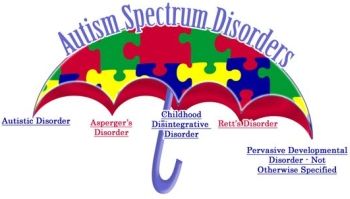
Publisher:
Bonnie King
CONTACT:
Newsroom@Salem-news.com
Advertising:
Adsales@Salem-news.com

~Truth~
~Justice~
~Peace~
TJP
Jan-27-2012 14:40

 TweetFollow @OregonNews
TweetFollow @OregonNews
Changes in DSM-5 Autism Definition Could Negatively Impact Millions
Salem-News.com"The autism community strongly recommends that the proposed DSM-5 autism spectrum disorder diagnostic criteria be revisited with these concerns in mind," - Sallie Bernard, President of SafeMinds
 Courtesy: parenting4tomorrow.blogspot.com |
(WASHINGTON, D.C.) - Proposed changes to the diagnostic criteria for autism spectrum disorders in the American Psychiatric Association’s Diagnostic and Statistical Manual of Mental Disorders – 5 (DSM-5) will potentially disrupt appropriate and necessary services to hundreds of thousands of individuals in the US, hamper the ability to track the numbers of people with autism, and interfere with efforts to establish biological causes of autism.
“The proposed criteria make it significantly more difficult to qualify for an autism spectrum diagnosis and they completely eliminate the categories of PDD-NOS and Asperger’s Disorder,” stated Wendy Fournier, National Autism Association President. “In a well-intentioned desire to improve the specificity of an ASD diagnosis, the new criteria may, in fact, go too far and create unintended consequences. It is critically important that any diagnosis address all the symptoms of an individual and allow them the supports they need.”
The new criteria, rationale and previous criteria are available at: http://www.dsm5.org/ProposedRevisions/Pages/proposedrevision.aspx?rid=94
Currently, the federal government is spending millions of dollars to track prevalence of ASDs in 11 states; the 2000 birth cohort is due out this year. The Individuals with Disabilities Education Act (IDEA) requires schools to report the number of students with autism annually. Both sets of data have shown dramatic increases in autism spectrum disorders. One in 110 children in the US is now affected by autism compared to one in 10,000 in the early 1980’s. By significantly changing the criteria for diagnosis, the new DSM-5 will impair the ability of public health officials to compare future rates of autism spectrum disorders to past rates, since the definition will have changed. Accurate projections of trends in autism rates are critical to planning educational interventions, Medicaid and adult services.
"By analogy, if the medical community chose to only count melanoma in the future instead of all types of skin cancer, it would look like skin cancer rates had gone down, even though other types were still present and needed treatment,” said Ginger Taylor, Canary Party Executive Director.
In addition, incidence and prevalence are critically important to investigating environmental causes of autism. “Toxic exposures to the general population change over time and having good consistent epidemiology allows researchers to judge the likelihood of a toxin being involved in autism,” stated Eric Uram, SafeMinds Executive Director. “The APA’s new criteria should add a specific mechanism to map the old diagnoses onto the new ones in order to allow researchers to compare new and old datasets. We also would like to see the APA address the issue of regressive autism by including age of onset as part of the criteria. The etiologies of infantile vs. regressive autism may be entirely different, but the new criteria do not distinguish them in any way.”
A primary concern for parents is the likelihood that many children on the autism spectrum may not be diagnosed under the new criteria, thereby depriving them of appropriate early intervention and treatment.
“Even in the states that have passed autism insurance legislation, the tightening of the criteria for autism may exclude children who need treatment with Applied Behavior Analysis,” said Mary Holland, Managing Director of the Elizabeth Birt Center for Autism Law and Advocacy.
“Our organizations advocate that the criteria should err on the side of over-diagnosing rather than under-diagnosing since no harm is likely from providing educational services to a young child, but great potential can be lost by not providing treatment.” Early intensive treatment improves outcomes for children with autism, making it highly cost-effective for tax-payers when compared to providing adult services.
"The autism community strongly recommends that the proposed DSM-5 autism spectrum disorder diagnostic criteria be revisited with these concerns in mind," concludes Sallie Bernard, President of SafeMinds. “These issues are too important to remain unresolved.”
For more complete documentation of community concerns and questions, please visit www.safeminds.org. If your organization would like to sign onto these concerns, please contact weisman@safeminds.org.
 |
 |
 |
 End Israeli apartheid |
Articles for January 26, 2012 | Articles for January 27, 2012 | Articles for January 28, 2012


Quick Links
DINING
Willamette UniversityGoudy Commons Cafe
Dine on the Queen
Willamette Queen Sternwheeler
MUST SEE SALEM
Oregon Capitol ToursCapitol History Gateway
Willamette River Ride
Willamette Queen Sternwheeler
Historic Home Tours:
Deepwood Museum
The Bush House
Gaiety Hollow Garden
AUCTIONS - APPRAISALS
Auction Masters & AppraisalsCONSTRUCTION SERVICES
Roofing and ContractingSheridan, Ore.
ONLINE SHOPPING
Special Occasion DressesAdvertise with Salem-News
Contact:AdSales@Salem-News.com
Salem-News.com:


Terms of Service | Privacy Policy
All comments and messages are approved by people and self promotional links or unacceptable comments are denied.
Anonymous January 27, 2012 3:10 pm (Pacific time)
Stop taking the vaccines and watch autism dwindle to almost nothing.
[Return to Top]©2025 Salem-News.com. All opinions expressed in this article are those of the author and do not necessarily reflect those of Salem-News.com.